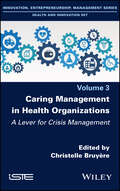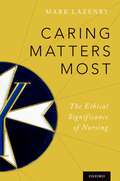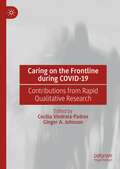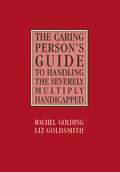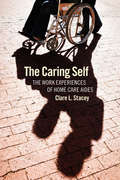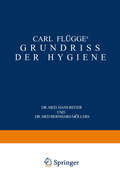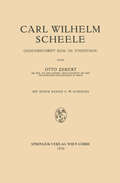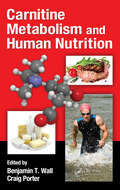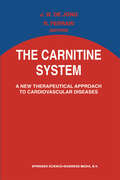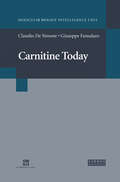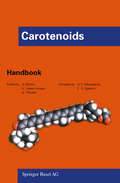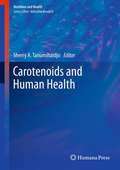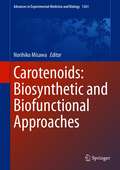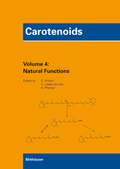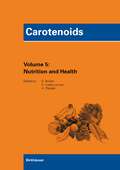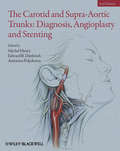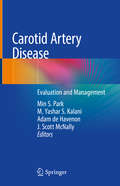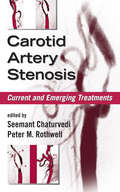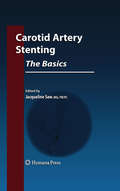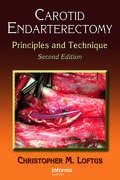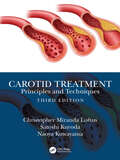- Table View
- List View
Caring Management in Health Organizations, Volume 3: A Lever for Crisis Management
by Christelle BruyèreCaring Matters Most: The Ethical Significance of Nursing
by Mark LazenbyThrough an exploration of the ethical nature of nursing, Caring Matters Most asserts that the act of nursing itself embodies goodness. Nurses can develop this moral character in themselves by cultivating five habits: trustworthiness, imagination, beauty, space, and presence. Practicing these habits will sustain nurses as they meet the challenges of the workplace, the threat of automation, and the incivilities that arise within the nursing community. The volume concludes with thought-provoking discussion questions and exercises designed to help nurses apply concepts in the classroom or in practice. Each chapter combines highly readable explanations of moral theory with real-life examples that can guide nurses in day-to-day practice. Caring Matters Most is an ideal resource for academic or practicing nurses interested in healthcare ethics or philosophy.
Caring Matters Most: The Ethical Significance of Nursing
by Mark LazenbyThrough an exploration of the ethical nature of nursing, Caring Matters Most asserts that the act of nursing itself embodies goodness. Nurses can develop this moral character in themselves by cultivating five habits: trustworthiness, imagination, beauty, space, and presence. Practicing these habits will sustain nurses as they meet the challenges of the workplace, the threat of automation, and the incivilities that arise within the nursing community. The volume concludes with thought-provoking discussion questions and exercises designed to help nurses apply concepts in the classroom or in practice. Each chapter combines highly readable explanations of moral theory with real-life examples that can guide nurses in day-to-day practice. Caring Matters Most is an ideal resource for academic or practicing nurses interested in healthcare ethics or philosophy.
Caring on the Frontline during COVID-19: Contributions from Rapid Qualitative Research
by Cecilia Vindrola-Padros Ginger A. JohnsonThis book examines the experiences of global healthcare workers during the COVID-19 pandemic. It shines a light on the experiences of healthcare workers during the pandemic, exploring their lived experiences of delivering care without losing sight of the emotional and symbolic nature of their work. Incorporating cutting-edge research from global experts in medical anthropology, medical sociology, medicine, psychology and nursing, it uniquely demonstrates the value of rapid qualitative research during infectious epidemics. Drawing on data collected during the COVID-19 pandemic, the book explores global healthcare policies and healthcare workers’ experiences across 20 countries.
The Caring Person's Guide to Handling the Severely Multiply Handicapped
by Rachel Golding Liz Goldsmith Martin Battye... this is a remarkable activity guide for a multi-disciplinary team in the field of multiple handicap.' Natfhe Journal
The Caring Self: The Work Experiences of Home Care Aides (The Culture and Politics of Health Care Work)
by Clare L. StaceyAccording to the Bureau of Labor Statistics, there were approximately 1.7 million home health aides and personal and home care aides in the United States as of 2008. These home care aides are rapidly becoming the backbone of America’s system of long-term care, and their numbers continue to grow. Often referred to as frontline care providers or direct care workers, home care aides—disproportionately women of color—bathe, feed, and offer companionship to the elderly and disabled in the context of the home. In The Caring Self, Clare L. Stacey draws on observations of and interviews with aides working in Ohio and California to explore the physical and emotional labor associated with the care of others. Aides experience material hardships—most work for minimum wage, and the services they provide are denigrated as unskilled labor—and find themselves negotiating social norms and affective rules associated with both family and work. This has negative implications for workers who struggle to establish clear limits on their emotional labor in the intimate space of the home. Aides often find themselves giving more, staying longer, even paying out of pocket for patient medications or incidentals; in other words, they feel emotional obligations expected more often of family members than of employees. However, there are also positive outcomes: some aides form meaningful ties to elderly and disabled patients. This sense of connection allows them to establish a sense of dignity and social worth in a socially devalued job. The case of home care allows us to see the ways in which emotional labor can simultaneously have deleterious and empowering consequences for workers.
Carl Flügge's Grundriss der Hygiene: Für Studierende und Praktische Ärzte, Medizinal- und Verwaltungsbeamte
by Carl FlüggeDieser Buchtitel ist Teil des Digitalisierungsprojekts Springer Book Archives mit Publikationen, die seit den Anfängen des Verlags von 1842 erschienen sind. Der Verlag stellt mit diesem Archiv Quellen für die historische wie auch die disziplingeschichtliche Forschung zur Verfügung, die jeweils im historischen Kontext betrachtet werden müssen. Dieser Titel erschien in der Zeit vor 1945 und wird daher in seiner zeittypischen politisch-ideologischen Ausrichtung vom Verlag nicht beworben.
Carl Wilhelm Scheele: Gedenkschrift Zum 150. Todestage
by Otto Zekert Carl Wilhelm ScheeleDieser Buchtitel ist Teil des Digitalisierungsprojekts Springer Book Archives mit Publikationen, die seit den Anfängen des Verlags von 1842 erschienen sind. Der Verlag stellt mit diesem Archiv Quellen für die historische wie auch die disziplingeschichtliche Forschung zur Verfügung, die jeweils im historischen Kontext betrachtet werden müssen. Dieser Titel erschien in der Zeit vor 1945 und wird daher in seiner zeittypischen politisch-ideologischen Ausrichtung vom Verlag nicht beworben.
Carnitine Metabolism and Human Nutrition
by Benjamin T. Wall Craig PorterCarnitine Metabolism and Human Nutrition offers a contemporary and in-depth look at the biological effects of carnitine metabolism and its application to clinical and sports nutrition, based on decades of robust scientific enquiry. It gathers and distills key results of the last 20 years of carnitine research to provide an invaluable reference tool
Carnitine Metabolism and Human Nutrition
by Benjamin T. Wall Craig PorterCarnitine Metabolism and Human Nutrition offers a contemporary and in-depth look at the biological effects of carnitine metabolism and its application to clinical and sports nutrition, based on decades of robust scientific enquiry. It gathers and distills key results of the last 20 years of carnitine research to provide an invaluable reference tool
The Carnitine System: A New Therapeutical Approach to Cardiovascular Diseases (Developments in Cardiovascular Medicine #162)
by R. Ferrari J. W. JongIn the last few years, derivatives of L-carnitine, such as acetyl-L-carnitine and propionyl-L-carnitine, have been made available to doctors for treatment of specific pathologies. The effects of this family of related carnitine compounds on cardiovascular systems and diseases constitute the major issue addressed in this volume. Although several books on carnitine have been published, a treatise focusing on experimental and clinical aspects of the carnitine family and cardiovascular diseases was lacking. The present book provides the reader with a concise update in this field. The information collected from experts on various aspects of the fascinating compound, carnitine, will be useful for both clinicians and basic scientists.
Carotenoids: Handbook
by George Britton Synnove Liaaen-Jensen Hanspeter PfanderWith the number of natural carotenoid structures reported rising above 700, there is a clear need for a single reference work containing data on all these compounds. This Handbook includes all natural carotenoids and common isolation artefacts for which structures have been assigned up to the end of 2001. For each compound, it provides selected key references and critically assessed information about natural occurrence and isolation, and spectroscopic data for identification. A standard full-page entry is given for each compound that has been characterised unambiguously, showing - Common name- IUPAC name- Structure, including stereochemistry, when assigned- Spectroscopic data: UV/Vis (with illustration); MS; CD; NMR (type and references)- Chemical synthesis (references)- Natural sources and outline of isolation procedure- Remarks, e.g. further spectroscopic data, stability, properties, derivatives- Selected key references
Carotenoids and Human Health (Nutrition and Health)
by Sherry A. TanumihardjoCarotenoids and Human Health provides an introduction to food sources and metabolism. Written by experts in their fields and including the most up-to-date information, this volume serves as an in-depth guide to studies that have been performed in humans and observations that have been made in population level assessments. Special emphasis is given to associations with disease, as well as the importance of carotenoids internationally, specifically as a source of vitamin A for the world. Comprehensive and easy to use, Carotenoids and Human Health is a very useful resource for nutritionists, registered dieticians, medical students, and graduate students.
Carotenoids: Biosynthetic and Biofunctional Approaches (Advances in Experimental Medicine and Biology #1261)
by Norihiko MisawaThis book provides a comprehensive overview of carotenoid biosynthesis by different organisms, including bacteria, archaea, fungi, arthropods, and plants. Carotenoids are thought to provide health benefits in areas such as cancer, diabetes, osteoporosis, NAFLD, NASH, obesity, age-related functional decline, and as a result, they have received an increasing amount of attention.With contributions from leading experts in biology, biotechnology, and chemistry of carotenoid research, this volume discusses the biological functions of carotenoids such as astaxanthin, β-cryptoxanthin, and fucoxanthin, in addition to paprika carotenoids, capsanthin, and capsorubin. It also reveals the technologies behind the commercial production of some functional carotenoids.The book is targeted for academic and industrial readers in biology, biotechnology, nutrient physiology and related fields.
Carotenoids, Vol. 4: Natural Functions (Carotenoids #4)
by George Britton Synnove Liaaen-Jensen Hanspeter PfanderThe Carotenoids book series provides an introduction to the fundamental chemistry, detailed accounts of the basic methods used in carotenoid research, and critical discussions of the biochemistry, functions and applications of carotenoids. Part 1 discusses the fundamental properties on which the biological functions and effects of carotenoids depend. Part 2 describes important natural functions of carotenoids in all kinds of living organisms.
Carotenoids Volume 5: Nutrition and Health (Carotenoids #5)
by George Britton Synnove Liaaen-Jensen Hanspeter PfanderThe Carotenoids book series provides an introduction to the fundamental chemistry, detailed accounts of the basic methods used in carotenoid research, and critical discussions of the biochemistry, functions and applications of carotenoids. The use of carotenoids against diseases is discussed. This volume is to be used in conjunction with the Carotenoids book series and the Carotenoids Handbook.
The Carotid and Supra-Aortic Trunks: Diagnosis, Angioplasty and Stenting
by Michel Henry Edward B. Diethrich Antonios PolydorouCarotid Angioplasty and Stenting (CAS) is a new approach to treat a carotid stenosis. This new book provides interventional cardiologists, both as beginners or fully experienced, with a reference on all aspects of angioplasty and stenting of the carotid and supra-aortic trunks. Focusing on both the entire range of angioplasty and stenting treatment options for the surgeon treating patients on the operating table, and the range of radiological techniques used for the cardiologist to diagnose carotid artery stenosis (CAS) and associated conditions, this important book describes the best indications, the different techniques, the results, and also the limitations of CAS based on randomized studies and particularly the last published data (CREST study). Suitable for both novice and experienced interventionalists, it also addresses diagnosis of a carotid stenosis and complications from CAS and how to manage them.
The Carotid and Supra-Aortic Trunks: Diagnosis, Angioplasty and Stenting
by Michel Henry Edward B. Diethrich Antonios PolydorouCarotid Angioplasty and Stenting (CAS) is a new approach to treat a carotid stenosis. This new book provides interventional cardiologists, both as beginners or fully experienced, with a reference on all aspects of angioplasty and stenting of the carotid and supra-aortic trunks. Focusing on both the entire range of angioplasty and stenting treatment options for the surgeon treating patients on the operating table, and the range of radiological techniques used for the cardiologist to diagnose carotid artery stenosis (CAS) and associated conditions, this important book describes the best indications, the different techniques, the results, and also the limitations of CAS based on randomized studies and particularly the last published data (CREST study). Suitable for both novice and experienced interventionalists, it also addresses diagnosis of a carotid stenosis and complications from CAS and how to manage them.
Carotid Artery Disease: Evaluation and Management
by Min S. Park M. Yashar S. Kalani Adam De Havenon J. Scott McNallyThis truly comprehensive title addresses all aspects of the evaluation and management of carotid artery disease. The extracranial carotid artery is an area of confluence for both medical and surgical specialists. Given its unique position and function in the body, disease states that involve the carotid artery require a unique approach to ensure the best outcomes for patients. Developed by a multidisciplinary team of thought leaders from across medical, surgical, and radiological disciplines, Carotid Artery Disease: Evaluation and Management provides a diverse resource where readers can find presentation, evaluation, and management recommendations for any process involving the extracranial carotid artery, be it related to atherosclerotic, traumatic, inflammatory, or even oncologic disease. Indeed this title is a unique offering in that one can find traditional, and even exclusively medical, conditions within the same binding as surgical or interventional ones. Typically, access to this type of information requires the purchase of multiple different texts, but this complete title distills the evaluation and management of carotid artery disease into a one-of-a-kind, practical, accessible reference. A much-needed and invaluable contribution to the clinical literature, Carotid Artery Disease: Evaluation and Management will be of great interest to anyone early in his or her career and needing an introduction to the field, as well as seasoned clinicians in need of state-of-the-art, refresher information.
Carotid Artery Stenosis: Current and Emerging Treatments (Neurological Disease And Therapy Ser.)
by Seemant Chaturvedi Peter M. RothwellProviding a thorough overview of rapid developments in medical therapy, surgery, and angioplasty, this reference provides a complete review of carotid artery stenosis treatment, as well as a clear overview of carotid surgery and stenting. Offering chapters by seasoned authorities on epidemiology, imaging with ultrasound and angiography, cholesterol
Carotid Artery Stenosis: Current and Emerging Treatments
by Seemant Chaturvedi Peter M. RothwellProviding a thorough overview of rapid developments in medical therapy, surgery, and angioplasty, this reference provides a complete review of carotid artery stenosis treatment, as well as a clear overview of carotid surgery and stenting. Offering chapters by seasoned authorities on epidemiology, imaging with ultrasound and angiography, cholesterol
Carotid Artery Stenting: The Basics (Contemporary Cardiology)
by Jacqueline SawOver the past three decades, carotid artery stenting has evolved to become a promising and viable alternative to carotid endarterectomy, especially for patients deemed to have high surgical risks. In Carotid Artery Stenting: The Basics, Jacqueline Saw and a panel of international experts on carotid artery stenting discuss in depth the details of all contemporary aspects of carotid stenting, while reviewing supporting studies, guidelines, technical perspectives, and peri-procedural management. This textbook serves as a learning resource on the multifaceted management of patients with carotid artery stenosis, with the key focus on extracranial carotid artery stenting. Additional sections detail the specifics of setting up and maintaining a laboratory and discuss the preparation of the carotid artery stenting procedure from both the patient and operator’s perspective. Authoritative and highly practical, Carotid Artery Stenting: The Basics is an accessible guide and valuable resource for today’s cardiologists, radiologists, and vascular surgeons.
Carotid Endarterectomy: Principles and Technique
by Christopher M. LoftusWith 50% new photos and a vast selection of current clinical cases, this source supplies an abundance of color images and provides illustrative sections on the patch graft technique, recurrent disease, complex and unusual carotid surgeries, and discussions of carotid complications and their remedies. As in the First Edition, color photographs are a
Carotid Treatment: Principles and Techniques
by Christopher Miranda Loftus Satoshi Kuroda Naoya KuwayamaScientific and epidemiologic progress surrounding carotid artery surgery continues to evolve, and for the better, for both surgeons and patients. Carotid surgery, performed by skilled surgeons with quantifiable results, prevents stroke in asymptomatic and symptomatic patients. The challenge is to continually refine the techniques to ensure the greatest possible margins of safety, and to educate surgeons around the world to ensure uniform standards of care. Carotid artery stenting, again performed by skilled practitioners with quantifiable results, has developed as a viable alternative to CEA in chosen cases. Carotid Treatment, Third Edition represents the current state of the art in carotid treatment. Coverage includes a comprehensive and practical new chapter on carotid stenting, increased coverage of radiography, and highly illustrated surgical technique case examples reflecting international practice. Throughout the book numerous case examples, and interesting examples of anatomical variants are illustrated and explained. An expanded section on complications further increases the value of this resource for all practitioners. Highly illustrated text to aid understanding of best practice in carotid treatment Reflects international best practice Useful in clinical practice and to improve patient care Neurosurgeons, Vascular surgeons, and Neuro-Interventionalists will benefit from the experience and wisdom shared in the third edition of this acclaimed text.
